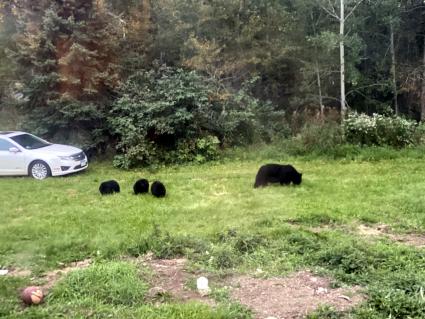Bear issues continue in Grand Marais and North Shore area in fall 2020
Bears spending entire afternoons sleeping in the backyards of local residents in Grand Marais. Sows growling from the branches of trees above city sidewalks. Cubs meandering through lawns while children ride their bicycles just a stone’s throw away. The bear stories continue to mount along the North Shore and throughout Cook County in 2020.
Andrew Tri is a bear biologist for the Minnesota Department of Natural Resources. He spoke with WTIP about problem bears as the summer of 2020 started to wind down. Tri spoke again heading into October about continued reports of bear-human interactions and conflicts, including many reports from inside Grand Marais city limits.
Tri says there have been continued reports of bears in towns along the North Shore because of a lack of natural foods in the local woods. Increased bear activity in town doesn’t require taking any drastic measures for one’s own safety, Tri points out, but it does require patience, tolerance and extra vigilance to ensure bears do not get an easy meal.
Furthermore, Tri says the influx of bears into town is not because the bear population has exploded but because bears are hungry right now. This is what happens during bear food failures. Statewide bear populations are relatively low, compared to the peak in the early 2000s (12,000–15,000 vs. 25,000, respectively).
Natural bear foods conditions are the worst in about 10 years throughout northeastern Minnesota, according to the DNR. This food shortage, combined with abundant bear attractants like birdseed, dumpsters and unsecured trash have resulted in increased human-bear conflict. Food conditions inland from Lake Superior are worse, which may drive bears to the North Shore and places like Grand Marais where food conditions are better and people have fruit trees.
The DNR encourages people to remove or lock up attractants (trash, birdseed, etc.) so bears can’t access them. Pick fruit from trees and collect any fallen fruit promptly. If not feasible to pick all the fruit, protect trees from damage by using an energized fence.
In related news, because of the high number of females killed in the bear hunt due to poor food conditions, a number of orphaned cubs have shown up in people’s yards or fruit trees. These cubs are usually large enough to survive on their own and do not need intervention. If you can tolerate it, letting them eat fruit from the trees will aid in their survival. Do not approach to take photos and let them get comfortable around people.
If you have questions, need to report a bear causing issues or have an orphaned cub in the yard, please call the DNR’s Area Wildlife Office at 218-834-1453 or email twoharbors.wildlife@state.mn.us for assistance.
Unless it is an emergency, Tri says to use the contacts above rather than a local DNR conservation officer or the Cook County Sheriff’s Department. More resources on how to prevent bear issues can be found at the DNR’s 'Living with Bears' website or Bearwise.org.
Below is an interview with WTIP’s Joe Friedrichs and Tri about continued reports of problem bears and bear activity in autumn 2020.
Tweet







